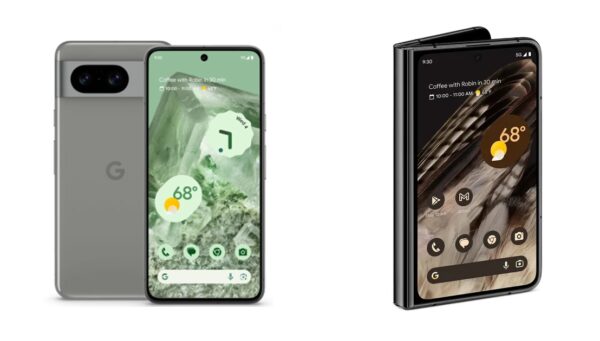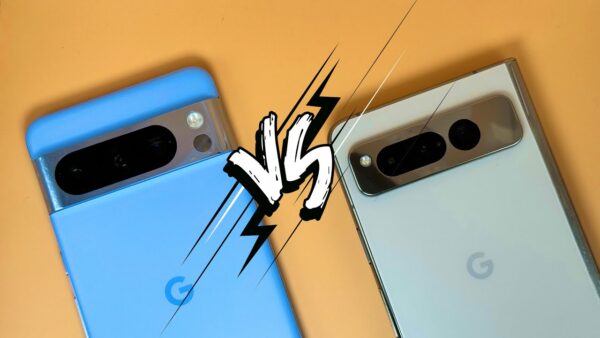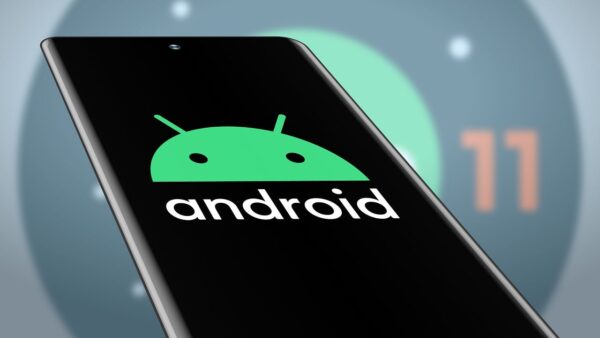There have been lots of talks about Google Pixel Fold vs Pixel 8 Pro. A comparison between them will help you know which one suits you best. The new Google Pixel Fold ranks among the top foldable phones from Samsung, OnePlus, and Motorola. Google definitely impressed all smartphone lovers with this one. Similarly, the slab-like Pixel 8 Pro is one of the best in every aspect.

Overview
If you are stuck between Google's latest flagship phone and their first foldable, we are happy to help you make an informed decision. Like the 8 Pro, the Pixel Fold offers a super-smooth Android experience and can take on just about any task. You can also use it like a portable mini tablet. Also, both Pixel phones are top of the class in terms of hardware, display, camera, and compatibility with other devices.
Many buyers favor the Pixel Fold for its unconventional build, which lets them access a larger display. However, the Pixel 8 Pro has more extended software support and costs just above half the price of the Pixel Fold. It is even one of our recommended Android phones. The question of the day is whether you should splurge on a foldable screen. Let's find out together.
Design
Design is the conspicuous variance between the Google Pixel Fold vs Pixel 8 Pro. While the Fold boasts a more interesting design, the 8 Pro maintains the Pixel 6's slab build with a visor-like camera bump on the backs. The Fold also sports a camera bump, but it doesn't go all the way to the edges. Both phones are built with higher-end materials based on their design style.
The Pixel Fold is thin and unfolds sideways like a book. When folded, this refined design gets you a wide inner display and an outer display the size of a compact Android. This phone sports a polished aluminum frame holding the front and back glasses together with plastic fittings. Its fold feature relies on a stainless steel hinge. Along with an IPX8 water and dust resistance rating, you also get an incredible design weighing only 283 grams. Furthermore, its fingerprint sensor, speakers, volume/power buttons, mic, and USB-C port are lined across the Aluminum frame.
On the other hand, the Pixel 8 Pro boasts a matte frosted glass back, Gorilla glass in front, and an aluminum frame. The signature visor housing the rear camera system is also aluminum and blends into the frame. The phone's water and Dust resistance rating is IP68, and Google says it is safe in up to 1.5m of water for 30 minutes. Overall, both phones are at the top of their games in terms of design and dimension. There is no winner in this aspect.
Dimension and Colors
Most foldable phones with this design have outer screens with awkwardly tall aspect ratios. However, the Pixel Fold feels more like a regular phone when folded, thanks to its wide build. Regarding dimension, the Fold measures 139.7 x 158.7 x 5.8 mm in full form and 139.7 x 79.5 x 12.1 mm when folded. Meanwhile, the 8 Pro measures 162.6 x 76.5 x 8.8 mm and weighs 70 grams less. Both phones are available in Porcelain and Obsidian, while the 8 Pro adds Bay and Mint to the color options.
Chipset, Software, and Performance
Google rolls the Pixel 8 Pro with Android 14 out of the box. Meanwhile, the Fold enters the market with Android 13 and can be upgraded to 14. Both phones perform superbly and can take on just any app or activity. Moreover, the Fold has a few extra perks to suit its giant main and cover screens.
Google redesigned most of their first-party apps to look stunning on larger screens. You can also split two apps and work on them simultaneously (one on each half of the screen). However, only one app reopens if you close and open the phone.
Furthermore, the Tensor chip generation is different between both phones. While the Fold runs on the Tensor G2 chipsets, you can enjoy additional perks from the latest Tensor G3 chipset in an 8 Pro. Machine learning and AI capability are the major additions to the new Tensor G3 chip. The extra AI features set a new record in the Google Pixel Fold vs Pixel 8 Pro race.
These enhancements facilitate the photo editing features peculiar to the Pixel 8 Pro but do not substantially impact performance. For instance, you'll struggle to notice any disparity aside from the extra screen space when gaming. Lastly, it's ironic that the photo editing features exclusive to the Pixel 8 Pro would be easier to use on the Pixel Fold.
Regarding software support, the Pixel 8 Pro is the obvious winner. Google promises seven years of software and security updates for the Pixel 8 Pro. Meanwhile, the Pixel Fold gets just three years of software updates and five years of security updates.
Display
Google's Pixel 8 Pro is top-class in all ramifications. Its screen comprises an 6.7-inch LTPO OLED display panel with 2,400 nits of peak brightness and a refresh rate of 120 Hz. It supports HDR10+ and Always-on display. Its screen-to-body ratio is 87.4% with an aspect ratio of 20:9 and screen resolution of 1344 x 2992 pixels. The screen has nice, slim bezels and an Immortalis-G715s MC10 GPU.
For the Pixel Fold, you get a 7.6-inch foldable OLED display panel with 1,450 nits of peak brightness—impressive but way below the 8 Pro. This screen has a resolution of 1840 x 2208 pixels and an 82.7% screen-to-body ratio. When folded, you can use the 5.8-inch OLED outer screen, which has a refresh rate of 120 Hz like the 8 Pro’s. Its aspect ratio is 17.4:9, and its screen resolution is 1080 x 2092 pixels. Lastly, you get HDR10+ support and 1,550 nits of peak brightness.
Corning's Gorilla Glass Victus 2 is the common protection glass for both phones' screens. Despite the Fold's secondary screen, it is the inferior option in terms of display. The 8 Pro has a sharper and brighter display.
Camera

There is no Google Pixel Fold vs Pixel 8 Pro debate in terms of camera and image quality. Although both phones shoot 4K videos, it is simply unfair to compare both phones based on camera quality. Every gadget lover knows that the Pro models in the Pixel lineup always boast phenomenal cameras.
For the Fold, you get three camera systems, so you can take selfies using either screen. The primary tri-camera setup at the rear comprises a 48 MP wide and two 10.8 MP (ultra-wide and telephoto) sensors. Furthermore, you get an 8 MP camera for selfies and a 9.5 MP camera that you can use with the secondary screen. You can see that this rear camera setup is not a slouch; it's the 8 Pro's smart camera features that set things ablaze.
The Pixel 8 Pro boasts a 50MP primary sensor and 48MP ultrawide and telephoto cameras. This rear setup has dual-pixel PDAF, multi-zone Laser AF, 5x optical zoom, panorama, and Ultra HDR support. The sole front-facing selfie camera is a 10.5 MP ultra-wide sensor. It captures excellent photos and uses AI focus to enhance image quality in portrait mode.
Additionally, the Fold has an unexpected edge over the 8 Pro for selfies. You can use the rear camera for selfies, with the external screen as a viewfinder. This way, you don't need to rely on the front-facing selfie cameras to use the screen to help perfect your shot.
Battery and Charging
The 8 Pro is the flawless winner of the Google Pixel Fold vs Pixel 8 Pro comparison in terms of battery and charging. While the 4,281 mAh Li-Po battery that powers the Pixel Fold impresses with a over-average battery life and wireless charging support. If you are looking for more, opt for the Pixel 8 Pro with a 5,050 mAh Li-Po battery. This battery lasts for over 16 hours per charge and supports fast charge speeds for wired and wireless charging. Its 30W wired charging can add up to 50% from zero in only thirty minutes using the correct USB TypeC charger. Also, both phones have PD3.0 wired charging support.
Pricing
Foldable design phones, including the Pixel Fold, are currently very expensive. All available Pixel Fold options rely on a 12GB RAM. The 256GB storage version starts at about $1,799, while the one with 512GB will set you back $1,999.
Similarly, all Pixel 8 Pros have 12GB of RAM with four internal storage versions. Options with 128GB starting at $999, 256GB going for $1,059, 512GB at $1,179, and finally, those with 1TB cost at least $1,399.
Therefore, the Google Pixel Fold vs Pixel 8 Pro conversation tilts towards the latter regarding cost efficiency. Even the most expensive option with 1TB of internal storage costs $400 less than the base Fold. Lastly, you can order both phones from the Google Store, Amazon, Best Buy, and top retailers. Verizon and some mobile providers also offer payment plans and warranty packages.
Conclusion
Google seems to have struck gold with the Pixel 8 Pro. It aced the Google Pixel Fold vs Pixel 8 Pro debate thanks to its superior performance, battery life, cameras, and Google AI features. Furthermore, the Pixel Fold is superb for early adopters and people willing to splurge on a futuristic experience. Foldable devices are unlocking a new wave of improved multitasking and multi-app windows support. When they arrive, these early adopters will be the first to take advantage of these new technologies. So, if this is a priority for you, you know which way to go.















